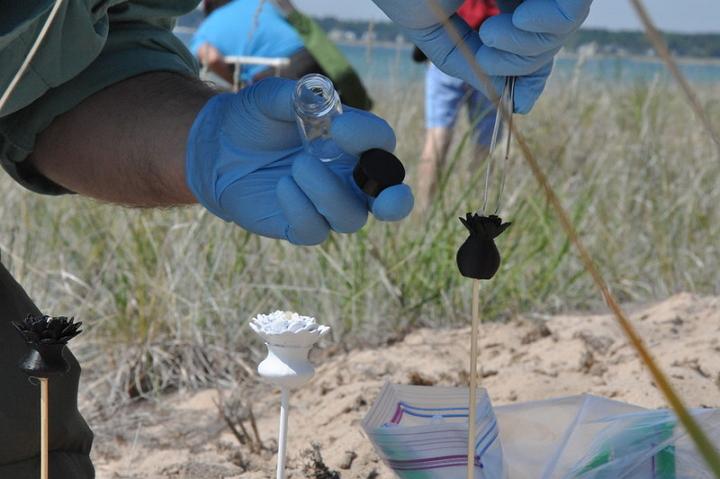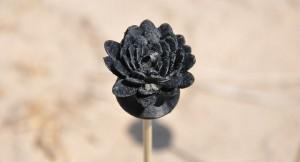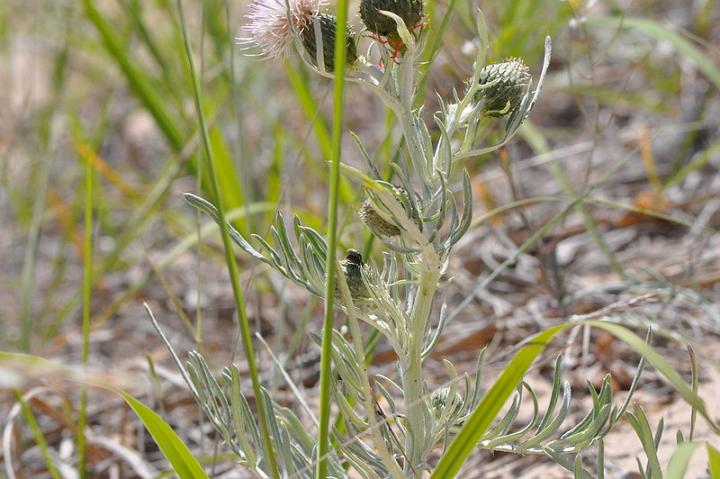Throwing Mother Nature a Curveball with 3D Printed Thistles
 The Pitcher’s thistle is a spiky, noxious looking plant distributed along the sandy shores of the Great Lakes, and while it may not be the most lovely plant, it is a critical resource to pollinators that make their homes in the dunes around the lakes.
The Pitcher’s thistle is a spiky, noxious looking plant distributed along the sandy shores of the Great Lakes, and while it may not be the most lovely plant, it is a critical resource to pollinators that make their homes in the dunes around the lakes.
Plant conservation scientists working at the Chicago Botanic Garden have created a set of 3D printed ‘flowers’ meant to confuse a type of weevil and preserve a critical plant species in the dunes which surround the Great Lakes.
“The weevils are an example of a biocontrol gone bad,” says conservation scientist Dr. Pati Vitt. “While Pitcher’s thistle was already threatened due to habitat destruction, it was holding its own until the seed-eating weevil, Larinus planus, came along.”
 The balance of nature is delicate, and even slight changes to a bio-environment can have unintended and far-reaching consequences. When this particular weevil was introduced into this country during the 1960s, it was meant to control what was considered a noxious thistle species. But along with the targeted plant, scientists discovered that the weevil was destroying the Pitcher’s thistle along the sand dune shorelines of Michigan, Wisconsin, Indiana, Illinois and Ontario.
The balance of nature is delicate, and even slight changes to a bio-environment can have unintended and far-reaching consequences. When this particular weevil was introduced into this country during the 1960s, it was meant to control what was considered a noxious thistle species. But along with the targeted plant, scientists discovered that the weevil was destroying the Pitcher’s thistle along the sand dune shorelines of Michigan, Wisconsin, Indiana, Illinois and Ontario.
To combat the weevil, Vitt and a team at the Harold Washington Library Center Maker Lab in Chicago created their 3D printer technology to mimic the look of the Pitcher’s thistle, and over the course of a year, the team designed 60 plastic flowers and analyzed the scent of the Pitcher’s thistle.
Last month, Vitt and her colleague Jeff Gorra placed their 3D printed versions of the thistle near a patch of the real flowers, and each of them was treated with a scent for testing. As the team observed the results, the 3D printed plant models were moved to the most advantageous locations and located randomly among the target plants.
The team found that though the weevils which were originally targeted didn’t show the expected result, the scientists did discover something of interest about the 3D printed flowers in a second trial. 
“They were of great interest to other insects, including pollinators,” says Vitt. “When comparing the visitation rates of the real flowers to the fake flowers, they look fairly similar. This is a big deal because it offers evidence that these floral mimics provide visual and scent cues that cause insects to go from the real to the 3D printed flowers.”
Pitcher’s thistle is key to the activities of some 30 species of pollinators, and it’s crucial to a variety of mammals, birds and insects. The Monarch butterfly also finds the thistle of use as it’s usually available to those butterflies during a critical phase in their annual migration.
 Species-control efforts have been used to intervene on a number of occasions in the past. In this case, the weevil’s attach on the Pitcher’s thistle led to it being listed as a threatened species in 1988 by the US Fish and Wildlife Service.
Species-control efforts have been used to intervene on a number of occasions in the past. In this case, the weevil’s attach on the Pitcher’s thistle led to it being listed as a threatened species in 1988 by the US Fish and Wildlife Service.
Using examples of the plastic flowers in three colors, all of them of them in various stages of simulated bloom which are placed on 20-inch-long dowels, the flowers were treated with scents via cotton wicks saturated with smells thought to attract weevils.
Do you know ofany other efforts being made to use 3D printing to intervene in natural processes gone wrong? Let us know in the Fooling Nature With 3D Printing forum thread on 3DPB.com.
Subscribe to Our Email Newsletter
Stay up-to-date on all the latest news from the 3D printing industry and receive information and offers from third party vendors.
Print Services
You May Also Like
New FABRX Study Says 3D Printed Pills Cuts Costs by 35%
For patients who need specially made medications, traditional pharmacy methods can be slow, expensive, and not always precise. FABRX is changing that with 3D printing, making personalized prescriptions faster, safer,...
Campus Alert: UK Tightens Controls on 3D Printed Firearms at Universities
United Kingdom (UK) authorities are warning that while 3D printing is an incredible tool for innovation, it’s increasingly being misused to for homemade guns, a problem seen in recent cases...
3D Printing News Briefs, January 18, 2025: Executives & Materials
We’re starting today’s 3D Printing News Briefs off with some business news, as RadTech announced a new president and board members, Xometry appointed a president and Chief Marketing Officer, and...
Cracking the Case: How Police and Science Took Down a 3D Printed Gunsmith
It started with a tip in January 2022. Police in the West Midlands region of the UK launched Operation Captiva after receiving information that something suspicious was happening in one...


























